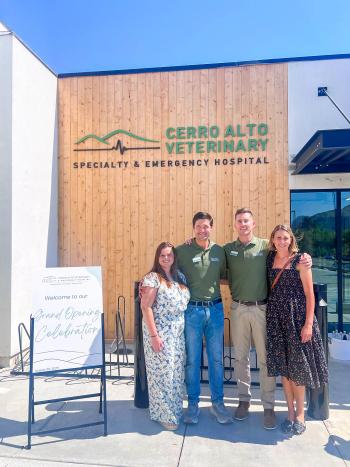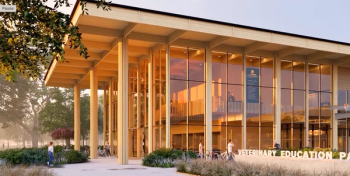
New hospital reuses, recycles from the old
Temporary space, recycled materials, and the passing away of a family member: How one family pulled through and triumphed with their Hospital Design Merit Award winner.
Dr. Joseph Kendrick wanted a clinic that would make an impression. Such a big impression that people would drive by and almost have a wreck. "I saw a lady the other day who drove by and then turned around and drove by again with her mouth hanging open, saying, 'Wow,'" he says.
Goal achieved. And when clients make it inside the front door, they see an inviting, comfortable, practical space where they feel right at home, he says. For one thing, the clinic is familiar to clients because the facility stands right where the old hospital once was. When the old clinic was demolished, the practice used an office building on the site as a temporary facility during construction. It's now attached to the new building by a hallway. With plenty of room for future expansion, this space houses the staff break room.
Lots of visibility also makes clients comfortable, Dr. Kendrick says. Windows (with blinds for optional privacy) provide views into grooming, and a glass door in the special procedures room gives clients a view of the high-tech equipment. A self-service retail store lets pet owners grab the food they need and pay at the reception desk.
Give signage some space
Dr. Kendrick says he wanted the clinic's profit centers at the front of the building to raise clients' awareness of all the services the practice team offers. "It would pain me if we had these great facilities but nobody knew about them because they were hidden in the back," he says.
Smile! "We haven't seen pet photography in any other hospital," says Dr. Joseph Kendrick. "We couldn't figure out why. So we went to Olan Mills, JCPenney, and Sears. They told us they don't photograph pets because workers' compensation doesn't cover the employees. It doesn't work for them in the same way because they don't have a captive audience. And the first time a pet crapped on the floor at Olan Mills, that would be the end of it. But in a veterinary clinic, you're used to cleaning up all the time. Our clients love the photo studio. They say, 'Boy, you guys do everything here.'"
To make sure he achieved his goals for the project, Dr. Kendrick did a lot of planning on his own before contacting an architect. "Most architects don't know how you want to practice medicine," he says. "I've practiced for 30 years and seen faults with my old clinics. I wanted to eliminate those faults with our new design."
A look at the numbers
The cat's meow: When team members show clients the new hospital, they always take them by the cat boarding area. The glass-back cat condos with views to the outside make kitties feel right at home-and clients love it. Dr. Kendrick says feline boarding is full almost all the time.
All in the family: Dr. Kendrick, in the special procedures room with his son Dr. Ricardo Kendrick, says he always gets the final word when it comes to making decisions in the family practice. "But I'm diplomatic enough to plant an idea in their heads so they think they thought of it first," he says. So how does the family make working together work? They set boundaries, with each person responsible for certain things. "If I hear my wife (the clinic coordinator) and my daughter-in-law (the office manager) discussing an employee or a client problem, I immediately turn and walk away so I don't have to get involved," Dr. Kendrick says.
Working through the pain
Newsletter
From exam room tips to practice management insights, get trusted veterinary news delivered straight to your inbox—subscribe to dvm360.






